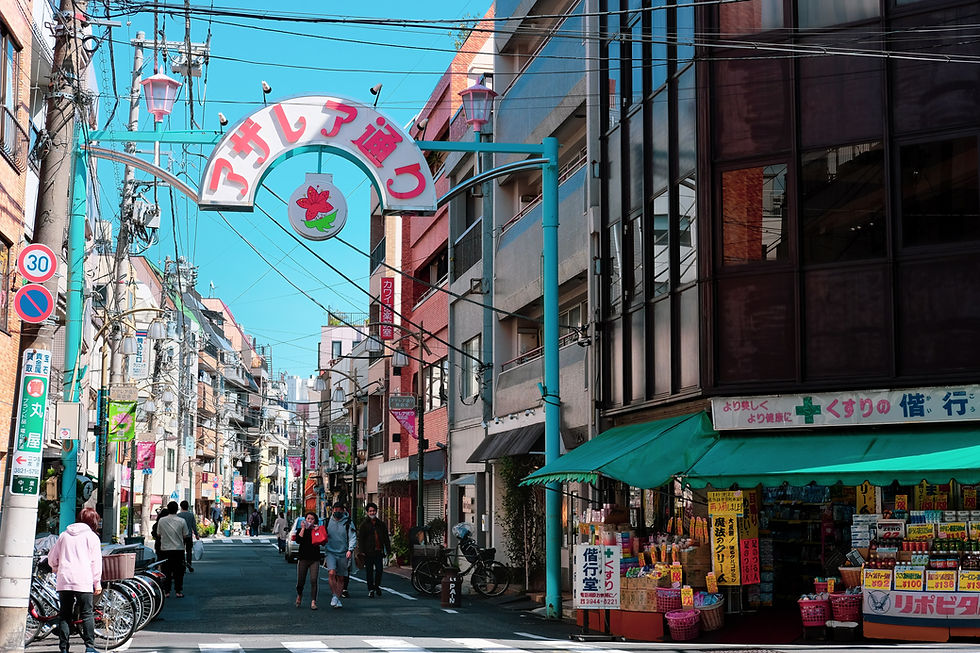If You Want to See a Shotengai in Japan: (Not Nakamise, But….)
- Half Rats Studio

- Jul 19, 2025
- 3 min read

Culinary travels and street food exploration are undoubtedly at the top of any Tokyo visitor’s list, whether you're a hard-core foodie or simply curious about local flavors. But beyond the usual suspects—the bustling outer market of Tsukiji or the packed alleys of Nakamise in Asakusa—there lies another world of culinary and cultural richness waiting to be discovered. No more squeezing through crowds just to queue for a single senbei.
Instead, step into the heart of local Tokyo through its shotengai—traditional shopping streets that have quietly served their neighborhoods for generations. These arcades and avenues offer more than just snacks; they provide a window into the everyday life of Tokyoites, blending history, community, and culinary craft in one walkable stretch.
The history of shotengai dates back to the Edo period, when merchants and vendors clustered near temples, shrines, and transport hubs to serve pilgrims and travelers. Over time, these streets evolved into neighborhood lifelines—places where families did their daily shopping, children bought after-school treats, and elders gathered for friendly chats. While Japan has modernized rapidly, these shotengai remain essential, preserving local food traditions and crafts in a way that mega-malls and convenience stores never could.
Kichijoji Sun Mall: Nestled near the ever-popular Inokashira Park, Kichijoji Sun Mall is a lively shopping arcade that reflects the youthful, creative spirit of the Kichijoji neighborhood. Lined with a mix of local boutiques, long-established eateries, and quirky shops, the mall offers a charming blend of old and new. Whether you're hunting for handmade crafts, savoring taiyaki from a beloved snack stand, or people-watching at a café, Sun Mall captures the cozy, community-focused vibe that makes Kichijoji one of Tokyo’s most beloved areas.
Access: Just outside the North Exit of Kichijoji Station (JR Chuo Line, Keio Inokashira Line).
Togoshi Ginza Shopping District: Togoshi Ginza is Tokyo’s longest shopping street, stretching over 1.3 kilometers with more than 400 shops, many of which are family-run. Known for its retro charm and strong neighborhood ties, the district is a haven for food lovers, with sizzling croquettes, yakitori, and freshly baked treats sold right from shopfronts. The atmosphere is friendly and unpretentious, offering a rare glimpse into everyday Tokyo life far from the glitz of tourist-heavy areas. Togoshi Ginza blends tradition and affordability, making it a favorite among locals.
Access: A short walk from Togoshi Ginza Station (Tokyu Ikegami Line) or Togoshi Station (Toei Asakusa Line).
Koenji Pal Road: Koenji Pal Road is a vibrant shotengai that perfectly mirrors the indie, bohemian culture of Koenji. Famous for its vintage clothing stores, live music venues, and eclectic dining spots, this shopping street buzzes with artistic energy. It's a hotspot for young creatives and those seeking Tokyo’s alternative side. Whether you're looking for a rare vinyl record, a handmade accessory, or just soaking in the local color, Koenji Pal Road offers an authentic, countercultural slice of the city.
Access: Located just outside the South Exit of Koenji Station (JR Chuo Line).
Shibamata: Time seems to slow down in Shibamata, a neighborhood steeped in nostalgic charm and Edo-period atmosphere. Known as the setting for the iconic "Tora-san" film series, Shibamata boasts cobblestone streets, traditional sweet shops, and the beautifully preserved Taishakuten Temple. The area offers a journey into Tokyo’s past, where wooden storefronts and friendly vendors invite you to explore a slower, more sentimental side of the city. It's an ideal spot for travelers looking to connect with the cultural heart of old Tokyo.
Access: A short walk from Shibamata Station (Keisei Kanamachi Line).
Sunamachi Ginza Shopping District: Hidden in Tokyo’s eastern Edogawa Ward, Sunamachi Ginza is a humble yet beloved shotengai that thrives on community and culinary warmth. Unlike larger commercial hubs, this street feels like a living kitchen, where vendors sell hearty street food like menchi-katsu and simmered oden to loyal neighborhood patrons. With its friendly banter and locally owned shops, Sunamachi Ginza offers a deeply local experience—an embodiment of the shitamachi spirit where everyday life is celebrated through food, conversation, and familiarity.
Access: From Minami-Sunamachi Station (Tokyo Metro Tozai Line), take a 15-minute walk or a short bus ride.
Visiting a shotengai offers a rare chance to experience the flavors and rhythms of a slower, more intimate Tokyo. You might sample a hand-fried croquette passed down through three generations, chat with the shop owner making pickles the old-fashioned way, or stumble upon a seasonal snack that never made it onto tourist radar. Prices are reasonable, people are friendly, and every alley has a story.
So skip the glossy guides and take a detour into the real Tokyo. Explore neighborhoods like Togoshi Ginza, where the smell of yakitori fills the air; Sunamachi Ginza, where oden simmers year-round; or Koenji Pal Road, where vintage vinyl stores sit next to nostalgic snack stalls. Each shotengai offers its own character—and each bite brings you closer to the soul of the city.



Comments